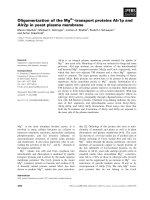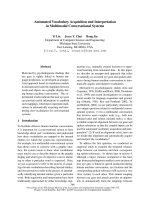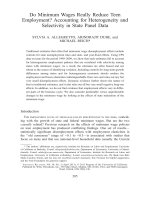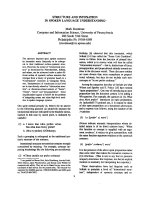Death, Grief and Poverty in Britain, 1870–1914 pptx
Bạn đang xem bản rút gọn của tài liệu. Xem và tải ngay bản đầy đủ của tài liệu tại đây (2.23 MB, 306 trang )
This page intentionally left blank
Death, Grief and Poverty in Britain, 1870–1914
With high mortality rates, it has been assumed that the poor in Victorian and
Edwardian Britain did not mourn their dead. Contesting this approach, Julie-
Marie Strange studies the expression of grief among the working classes, demon-
strating that poverty increased – rather than deadened – it. She illustrates the
mourning practices of the working classes through chapters addressing care of the
corpse, the funeral, the cemetery, commemoration and high infant mortality
rates. The book draws on a broad range of sources to analyse the feelings and
behaviours of the labouring poor, using not only personal testimony but also
fiction, journalism and official reports. It concludes that poor people used not
only spoken or written words to express their grief, but also complex symbols,
actions and, significantly, silence. This book will be an invaluable contribution to
an important and neglected area of social and cultural history.
JULIE-MARIE STRANGE is Lecturer in Modern British History at the University
of Manchester.
Cambridge So cial and Cul tural Histories
Series editors:
Margot C. Finn, University of Warwick
Colin Jones, University of Warwick
Keith Wrightson, Yale University
New cultural histories have recently expanded the parameters (and enriched the
methodologies) of social history. Cambridge Social and Cultural Histories
recognises the plurality of current approaches to social and cultural history
as distinctive points of entry into a common explanatory project. Open to
innovative and interdisciplinary work, regardless of its chronological or
geographical location, the series encompasses a broad range of histories of
social relationships and of the cultures that inform them and lend them meaning.
Histori cal anthropology, historical sociology, comparative history, gender
history and historicist literary studies – among other subjects – all fall within
the remit of Cambridge Social and Cultural Histories.
Titles in the series include:
1 Margot C. Finn The Character of Credit: Personal Debt in English Culture,
1740–1914
2 M. J. D. Roberts Making English Morals: Voluntary Association and Moral
Reform in England, 1787–1886
3 Karen Harvey Reading Sex in the Eighteenth Century: Bodies and Gender in
English Erotic Culture
4 Phil Withington The Politics of Commonwealth: Citizens and Freemen in Early
Modern England
5 Mark S. Dawson Gentility and the Comic Theatre of Late Stuart London
6 Julie-Marie Strange Death, Grief and Poverty in Britain, 1870–1914
Death, Grief and Poverty in
Britain, 1870–1914
Julie-Marie Strange
University of Manchester
cambridge university press
Cambridge, New York, Melbourne, Madrid, Cape Town, Singapore, São Paulo
Cambridge University Press
The Edinburgh Building, Cambridge cb2 2ru,UK
First published in print format
isbn-13 978-0-521-83857-3
isbn-13 978-0-511-12529-4
© Julie-Marie Strange 2005
2005
Informationonthistitle:www.cambrid
g
e.or
g
/9780521838573
This publication is in copyright. Subject to statutory exception and to the provision of
relevant collective licensing agreements, no reproduction of any part may take place
without the written permission of Cambridge University Press.
isbn-10 0-511-12529-1
isbn-10 0-521-83857-6
Cambridge University Press has no responsibility for the persistence or accuracy of urls
for external or third-party internet websites referred to in this publication, and does not
guarantee that any content on such websites is, or will remain, accurate or appropriate.
Published in the United States of America by Cambridge University Press, New York
www.cambridge.org
hardback
eBook (EBL)
eBook (EBL)
hardback
In loving memory of Sylvia Ann Bamber 1944–1993
Contents
Acknowledgements page viii
List of abbreviations x
1 Introduction: revisiting the Victorian and Edwardian
celebration of death 1
2 Life, sickness and death 27
3 Caring for the corpse 66
4 The funeral 98
5 Only a pauper whom nobody owns: reassessing
the pauper burial 131
6 Remembering the dead: the cemetery as a landscape
for grief 163
7 Loss, memory and the management of feeling 194
8 Grieving for dead children 230
9 Epilogue: death, grief and the Great War 263
Bibliography 274
Index 290
vii
Acknowledgements
Lots of people have encouraged and supported the writing of this book
either by reading parts of it, exchanging ideas over the topic or simply
telling me to get a move on and finish it; I would like to thank all of them,
especially Paul Johnson, including anonymous readers and referees.
Thanks also to the British Academy who funded the thesis. To the students
at Birkbeck College and the University of Manchester who took my Death
and Bereavement course, thank you for sharing your thoughts on this
subject and for making what could be a morbid topic to teach such a fun
and enjoyable experience. Thank you also to the editors at Cambridge
University Press for patience, feedback and support. It goes without saying
that all the omissions, mistakes and opinions cited here are entirely my
own. I would also like to thank the editors at Past and Present who published
a version of chapter 5 and at Social History who published an essay which
included versions of material here from chapters 3, 4 and 7.
In particular, howe ver, I wish to thank Jon Lawrence and Andrew
Davies who supervised the book when it started life as a thesis. Jon’s
blunt and honest criticism and Andy’s more soothing, diplomatic cri-
tiques made an excellent pairing and I couldn’t have wished for better
supervision. Added to this, the best food I ever ate throughout my thesis
and some years afterwards was on account of Jon, Jane and Joe’s generous
hospitality: thank you.
Bizarre as it may seem, I would like to thank the staff at Wavertree
Sports Centre in Liverpool; classes here saved my sanity on more than
one occasion. Geographical mobility means that many friendships shift
shape as the years go by and I would like to thank the many friends, old
and new, who have encouraged the writing of this book at different stages.
I would especially like to thank old friends Jane Collins and Heather
Ware. Special thanks also go to my sister Suzanne for friendship, love,
humour and support – and also, more recently, for introducing me to the
delights of being an aunt to a glorious Lily Rose. Special thanks to my
parents David and Christina Strange who have supported me unstintingly
viii
throughout my academic career (and, of course, beyond); I owe a great
deal to them. My husband George has lived with me and my book for the
last five years, has sat in my office until the early hours of the morning
when I wanted to finish something on numerous occasions and loved me
regardless of my quirks and foibles: thank you sweetheart.
Acknowledgements ix
Abbreviations
BALS Bolton Archives and Local Studies
BOHT Bolton Oral History Transcript
GRO Gloucester Record Office
LRO Lancashire Record Office
LVRO Liverpool Record Office
Man. OH Manchester Oral History
MOH Medical Officer of Health
PP Parliamentary Paper
PRO Public Record Office
WRO Wigan Record Office
YRO York Record Office
x
1 Introduction: revisiting the Victorian
and Edwardian celebration of death
There’s a grim one-horse hearse in a jolly round trot;
To the churchyard a pauper is going, I wot:
The road is rough, and the hearse has no springs,
And hark to the dirge that the sad driver sings:–
Rattle his bones over the stones;
He’s only a pauper, whom nobody owns
Poor pauper defunct! he has made some approach
To gentility, now that he’s stretched in a coach;
He’s taking a drive in his carriage at last,
But it will not be long if he goes on so fast!
Rattle his bones over the stones;
He’s only a pauper, whom nobody owns
But a truce to this strain! for my soul it is sad
To think that a heart in humanity clad
Should make, like the brutes, such a desolate end,
And depart from the light without leaving a friend.
Bear softly his bones over the stones,
Though a pauper, he’s one whom his Maker yet owns.
(Thomas Noel, c. 1839
1
)
At length the day of the funeral, pious and truthful ceremony that it was,
arrived two mutes were at the house-door, looking as mournful as
could be expected of men with such a thriving job in hand; the whole of
Mr Mould’s establishment were on duty within the house or without;
feathers waved, horses snorted, silk and velvets fluttered; in a word, as
Mr Mould emphatically said, ‘everything that money could do was done’.
(Charles Dickens, Martin Chuzzlewit, 1844
2
)
The pauper grave and the lavish funeral are notorious symbols of the
popular culture of death in the long nineteenth century. As the extracts
above demonstrate, the two funerals are easily juxtaposed as binary
1
‘The Pauper’s Drive’ by Thomas Noel cited in full in A. Wilson and H. Levy, Burial
Reform and Funeral Costs (London: Oxford University Press, 1938), 56.
2
Charles Dickens, Martin Chuzzlewit (London: Everyman, [1844] 1968), 309.
1
opposites in a literal and metaphorical sense: burial in a private grave was
the ‘cornerstone’ of respectability whilst to have a body buried on the
parish was to bear ‘a lifetime’s stigma’. The pauper grave signified abject
poverty and carried the taint of the workhouse; the pauper corpse was
tossed unlovingly into a pit to rot in anonymity; and, should anyone
mourn this creature, they were to be pitied. Conversely, giving the dead
a ‘good send off’ epitomised respectability; it provided an excellent
opportunity for revelry and display; and the funeral party were the object
of jealousy and social rivalry. As stereotypes, the excerpts above are
invariably linked to perceptions of the nineteenth century as a period
of booming consumer culture, expanding life insurance schemes and
punitive attitudes towards poverty. The poet Thomas Noel is well
known for championing the cause of the poor but historical perceptions
of the Victorian culture of death are largely derived from the journalism
and novels of Charles Dickens. An ardent critic of the Victorian ‘celebra-
tion of death’, Dickens ridiculed the middle and working classes for aping
the obsequious burial customs of the aristocracy. The tendency of the
populace to equate extravagant funerals with respectable status did little
more, he suggested, than render such spectacles absurd. That they were
‘highly approved’ by neighbours and friends reinforced the notion that
the disposal of the dead was a theatrical display where any concept of grief
was rooted in pride and snobbery rather than the personal expression of
loss.
3
Notably, when sincere cries of sorrow were manifest, they were
deemed inappropriate and contrary to the idea of the ‘genteel’ burial.
4
The facilitator of these exhibitions, the undertaker, was invariably cast as
a parasite, growing fat on a morbid diet of death, extravagance and social
jealousy.
5
Critical of the putrid and overcrowded churchyard, where
coffins and their contents spilled from the earth, Dickens was also
suspicious of the commercialisation of burial space, embodied in
profit-making joint-stock cemetery companies.
6
A thriving trade in
funeral dress and increasingly complex codes of mourning etiquette
signified a fascination with the macabre and required yet more needless
expenditure.
7
In contrast, pitiful burials ‘on the parish’ testified to the
3
See, for instance, the funeral of Pip’s sister in C. Dickens, Great Expectations
(Harmondsworth: Penguin, [1861] 1982), 298–301.
4
See Dickens, Martin Chuzzlewit, 312–13.
5
Ibid., 303–14. See also C. Dickens, ‘The Raven in the Happy Family’ in B. Matz (ed.),
Miscellaneous Papers of Charles Dickens (London: Chapman and Hall, [1850] 1908),
192–6.
6
See C. Dickens, ‘A Popular Delusion’ in H. Stone (ed.), Uncollected Writings from
Household Words (London: Allen Lane, [1850] 1968), 113–22. For references to over-
crowded churchyards see C. Dickens, Bleak House (London: Norton, [1853] 1977), 202.
7
See C. Dickens, ‘Trading in Death’ (1852) in Matz, Miscellaneous Papers, 349–58.
2 Death, Grief and Poverty in Britain, 1870–1914
punitive philosophy embedded in the New Poor Law.
8
Achampionof
funeral reform, Dickens called for burial to return to a mythical pastoral
idyll, as exemplified in the burial of Little Nell in a leafy, peaceful rural
churchyard.
Dickens excelled in portraying the sordid and proselytising against
social injustice and it is unsurprising that historians have fastened onto
the more spectacular aspects of the death culture present in his works to
conclude that bereavement in the nineteenth century was characterised
by consumerism and a preoccupation with social status.
9
Like many
dichotomies, however, the juxtaposed images of the pauper and the
respectable burial have lent themselves to oversimplification. Notably,
there is a tendency to refer to the contrasting burials as the single defining
feature of working-class attitudes towards death. This is not to suggest
that all accounts of death and burial have been reduced to a crude
dichotomy, but, rather, that such literature fails to grapple with the
cathartic effects of the funeral and the use of ritual as a forum for the
creation and expression of loss whilst overlooking the fluid meanings
invested in notions of respectability and pauperism.
Images of rampant commercialism and the horror of the pauper grave
have attributed the Victorian celebration of death with a sense of unique-
ness. To a point, of course, this is deserved. Victorian Britain witnessed
funerals of unprecedented ostentation, such as that for the Duke of
Wellington in 1852, a military spectacle which took three months to
organise.
10
Perhaps the most significant shift in burial practice lay in the
rise of the joint-stock cemetery company, a phenomenon that moved the
business of interment from the near-monopoly of the Anglican Church
into a commercial and multi-denominational arena. According to James
Curl, writing in the 1970s, the establishment of the commercial cemetery
sprang from interest in Romanticism and the desire to civilise the popu-
lace. By the 1820s, however, the sanitary issues raised by reports on
overcrowded graveyards, such as George Walker’s Gatherings from
Graveyards (1827), made the creation of extra-mural burial sites impera-
tive.
11
Other studies have emphasised the complex and overlapping
8
C. Dickens, Oliver Twist (Oxford: Oxford University Press, [1838] 1982), 25–33.
9
See especially J. Morley, Death, Heaven and the Victorians (London: Studio Vista, 1971)
and J. Litten, The English Way of Death: The Common Funeral since 1450 (London: Hale,
1991).
10
See O. Bland, The Royal Way of Death (London: Constable, 1986), 157 and J. Wolffe,
Great Deaths: Grieving, Religion, and Nationhood in Victorian and Edwardian Britain
(Oxford: Oxford University Press, 2000).
11
J. Stevens Curl, The Victorian Celebration of Death, 2nd edn (Stroud: Sutton, 2000), 1–36.
See also 1st edn (Devon: David & Charles, 1972).
Introduction 3
dynamics driving the establishment of commercial burial space: motives
included Dissenters’ protests concerning burial privilege, the need to
protect corpses from body-snatchers, and the desire to use commercial
space as a landscape for the expression of a secular identity.
12
More
recently, Patrick Joyce has examined the cemetery in Foucaldian terms
of liberal governmentality, suggesting that the organisation of the dead in
commercial burial space was inextricable from conceptions of the city as a
body needing careful regulation to maintain healthiness.
13
Focusing exclusively on the commercialisation of burial, Thomas
Laqueur’s essay ‘Religion and the Culture of Capitalism’ explored the
significance of the joint-stock cemetery company in shaping cultural
attitudes towards death. The move from traditional burial in the
Anglican parish churchyard to interment in the secular cemetery was,
Laqueur suggested, ‘a sign that the underlying cultural assumptions
of capitalism had taken root’.
14
The rise of the joint-stock cemetery
company was tantamount to trading in death, hitherto an outrageous
proposition. Founded on principles of profit, the cemetery represented ‘a
new kind of institution’ that enabled the expression of ‘new cultural
formations’.
15
This was especially evident in the distinction between the
private and the common grave, ‘an almost parodic equation’ of the gulf
between the respectable middle classes’ retreat into suburban privacy and
the poor who lived and died in public.
16
Overall, the language of the
commercial cemetery broke from a religious and reverential vocabulary to
speak unashamedly in consumerist terms that not only reflected social
12
J. Morgan, ‘The Burial Question in Leeds in the Eighteenth and Nineteenth Centuries’ in
R. Houlbrooke (ed.), Death, Ritual and Bereavement (London: Routledge, 1989),
95–104, S. Rawnsley and J. Reynolds, ‘Undercliffe Cemetery, Bradford’, History
Workshop Journal,4(1977), 215–21, R. Richardson, ‘Why was Death so Big in
Victorian Britain?’ in Houlbrooke, Death, Ritual and Bereavement, F. Barker (introduc-
tion) and J. Gay (photographs), Highgate Cemetery: Victorian Valhalla (London: Murray,
1984), J. Rugg, ‘The Emergence of Cemetery Companies in Britain, 1820–53’, unpub-
lished PhD thesis, University of Stirling, 1992, J. Rugg, ‘A Few Remarks on Modern
Sepulture: Current Trends and New Directions in Cemetery Research’, Mortality,3,2
(1998), 111–28 (118–20), J. Rugg, ‘Researching Early Nineteenth-Century Cemeteries:
Sources and Methods’, The Local Historian, 28, 3 (1998), 130–44, P. Jupp, ‘Enon
Chapel: No Way For the Dead’ in P. Jupp and G. Howarth (eds.), The Changing Face
of Death: Historical Accounts of Death and Disposal (Basingstoke: Macmillan, 1997),
90–104 and J. Pinfold, ‘The Green Ground’ in Jupp and Howarth, Changing Face of
Death, 76–89.
13
P. Joyce, The Rule of Freedom: Liberalism and the Modern City (London: Verso, 2003),
89–91.
14
T. Laqueur, ‘Cemeteries, Religion and the Culture of Capitalism’ in J. Garnett and
C. Matthew (eds.), Revival and Religion Since 1700 (London: Hambledon, 1993),
183–200 (185).
15
Ibid., 186.
16
Ibid., 197.
4 Death, Grief and Poverty in Britain, 1870–1914
change but ‘embodied it, making it manifest, translating it into emotion-
ally resonant forms’.
17
In highlighting this new ‘cultural pluralism’,
Laqueur possibly overplays his hand: the emphasis on change overlooks
continuities in burial practice, not least the overwhelming tendency for
most burial parties to request some form of religious burial service and
expression of denominational affiliation. Nevertheless, Laqueur’s thesis
that concepts of death were imbued with meaning in a larger web of
cultural transformation highlights the potential for shifting analysis of
the cemetery to new ground.
The expansion of the commercial cemetery was mirrored by a burgeon-
ing industry in funeral and mourning paraphernalia (clothing, jewellery,
stationery, shrouds, plumes, hearses and so on). At the heart of this
consumer market was the undertaker whose perceived greed is best
encapsulated in comparisons with the Vampire.
18
Much of the prejudice
against the undertaker sprang from the supplementary report of sanitary
commissioners into interment in towns in 1843. Authored by Edwin
Chadwick, the report drew attention to the undertakers’ marketing of
heraldic burial customs to a popular clientele.
19
With the expansion of
credit facilities to the working classes, the canny undertaker could exploit
the anxieties of the bereaved concerning their position within local social
and economic hierarchies. As Paul Johnson notes, the persistent financial
insecurity of most working-class families fostered a culture of saving for
extraordinary expenditure (the funeral is typical – but clothes, day trips
and ornaments are other examples). The items purchased subsequently
acquired a symbolism beyond their intrinsic economic value. Thus, for
people who owned very little, ‘almost any possession and the display of
this possession, was a way of broadcasting and establishing one’s social
worth’.
20
In this sense, expenditure became synonymous with a specif-
ically working-class concept of ‘respectability’ and the celebration of death
was ‘as popular in the slums of the East End as in the royal household’.
21
According to John Morley, the funeral thus epitomised the narrowness of
17
Ibid., 200.
18
J. Scandura, ‘Deadly Professions: Dracula, Undertakers and the Embalmed Corpse’,
Victorian Studies, 40, 1 (1996), 1–30.
19
Reports of Commissioners on Sanitary Condition of Labouring Population of Great
Britain: Supplementary Report on Result of Special Inquiry into Practice of Interment in
Towns, by Edwin Chadwick, PP 1843 (509) XII: 395. See also Samuel E. Finer, The Life
and Times of Edwin Chadwick (London: Methuen, 1952).
20
P. Johnson, ‘Conspicuous Consumption and Working-Class Culture in Late Victorian
and Edwardian Britain’, Transactions of the Royal Historical Society,38(1988), 27–42.
21
P. Johnson, Saving and Spending: The Working-Class Economy in Britain, 1870–1939
(Oxford: Clarendon, 1985), 11.
Introduction 5
working-class definitions of respectability, depending as it did on one
payment of burial club money.
22
The relationship between expense, respectability and notions of
decency has dominated historical discussion of the working-class culture
of death. Yet respectability was (and is) a slippery concept. A term
familiar to the Victorians, the conceptual fluidity of respectability gained
increasing recognition among historians in the 1970s alongside growing
interest in the divisions within the working classes which operated to
create separate and conflicting identities and interests.
23
Even Geoffrey
Best’s ‘brisk, conclusive and uncomplicated’ notion of respectability
(the aspiration to be a gentleman) acknowledged the adoption of the
‘respectable front’ by the working man.
24
Later studies located respect-
ability as a specifically working-class concept rather than one invoking the
absorption of middle-class values.
25
By 1979, Peter Bailey asserted that
respectability had moved from being ‘convenient and unfocused short-
hand’ for elite values to representing a notion ‘invested with a new
consequence and complexity’. Nonetheless, Bailey was critical of histor-
ians who continued to underestimate the dynamics of respectability, to
overlook its relation to human geography and the behaviour patterns of
the urban dweller and to portray it as a cultural absolute that pinned the
‘working-class respectable’ into a ‘characterological strait-jacket’.
26
Rather, Bailey contested, respectability was a role adopted in particular
situations and used as a ‘calculative’ or instrumental ploy in relations with
members of other social groups. More recently, Ellen Ross criticised
historians of respectability for their exclusive focus on male culture and
the workplace at the expense of analysing female identity. Ross further
suggested that the dichotomy between ‘rough’ and respectable, favoured
by Victorian and Edwardian commentators, drew on standards of moral
behaviour and material status. It was this link between the moral and
material that made respectability such a ‘mystifying word’ and which
22
Morley, Death, Heaven and the Victorians, 19–31. See also Curl, Victorian Celebration of
Death, 9–11.
23
Much of this interest was borne out of a critique of Hobsbawm’s ‘labour aristocracy’
thesis. See E. Hobsbawm, Labouring Men: Studies in the History of Labour (London:
Weidenfeld & Nicolson, [1964] 1979), 272–315.
24
P. Bailey on Geoffrey Best’s use of ‘respectability’ in ‘‘‘Will the Real Bill Banks Please
Stand Up?’’ Towards a Role Analysis of Mid-Victorian Working-Class Respectability’,
Journal of Social History, 12, 3 (1979), 336–53. See also G. Best, Mid-Victorian Britain,
1851–1875 (London: Fontana, [1971] 1979), 286.
25
See especially G. Stedman Jones, ‘Working-Class Culture and Working-Class Politics in
London, 1870–1900: Notes on the Remaking of the Working Class’, Journal of Social
History,7,4(1974), 460–508, and B. Harrison, Peaceable Kingdom: Stability and Change
in Modern Britain (Oxford: Clarendon, 1982).
26
P. Bailey, ‘Will the Real Bill Banks’, 336–7.
6 Death, Grief and Poverty in Britain, 1870–1914
continues to render the concept ‘confusing’ today. Pointing to the differ-
ing criteria for respectability according to social position, Ross was at
pains to emphasise that working-class respectability was not ‘a filtered-
down version of its bourgeois forms’. Rather, respectability referred to a
‘fluid and variable idea’ which was constantly redefined. Those who
adhered to fixed definitions of respectability often did so to their own
cost: it meant fiercely defending privacy and prohibited borrowing money
or goods whilst militating against participating in gossip and wider social
networks of friendship and exchange.
27
If respectability was so fluid, is it not possible that the concept of the
respectable funeral was also subject to multiple, diverse and highly indi-
vidual interpretations? This is not to dismiss respectability from analyses
of working-class culture, but, rather, to suggest that almost glib refer-
ences to the funeral as the touchstone of working-class respectability need
further exploration. Definitions of the ‘respectable funeral’ were usually
set in opposition to the pauper burial. Passed by the Whig government in
1834, the New Poor Law inaugurated the era of the workhouse wherein
the pauper grave came to represent the harshness and stigma of the new
regime. Often referred to as a ‘pit’, the pauper grave was little more than a
hole into which the bodies of the abject poor were packed in flimsy
coffins, with little or no ceremony: it was the ‘ultimate degradation’ for
the individual and the ‘ultimate disgrace’ for a Victorian worker’s
family.
28
Two years prior to the passage of the New Poor Law, the
Anatomy Act legitimised the donation of the unclaimed pauper dead to
anatomy schools for dissection. Previously reserved as a post-mortem
punishment for hanged felons, the Act was perceived as a direct assault
on the liberty and beliefs of the poor. Assessing popular response to the
Anatomy Act, Ruth Richardson concluded that fears for the integrity of
the corpse shaped the Victorian culture of death: the trappings of increas-
ingly expensive funerals were indicative of a desire for a secure burial
(with double and triple lead-lined coffins for instance) rather than a
simple reflection of growing consumer markets.
29
To a point, this is a
convincing thesis. It is worth noting, however, that the Anatomy Act only
27
E. Ross, ‘‘‘Not the Sort that Would Sit on the Doorstep’’: Respectability in Pre-World
War One London Neighbourhoods’, International Labour and Working Class History,27
(1985), 39–59.
28
C. Chinn, Poverty Amidst Prosperity: The Urban Poor in England, 1834–1914 (Manchester:
Manchester University Press, 1995), 104, and F. M. L. Thompson, The Rise of
Respectable Society: A Social History of Victorian Britain, 1830–1900 (London: Fontana,
1988), 200.
29
R. Richardson, Death, Dissection and the Destitute (London: Routledge & Kegan Paul,
1987).
Introduction 7
ever applied to unclaimed pauper corpses and that, by the latter decades
of the nineteenth century, poor law guardians increasingly refused to
co-operate with the demands of anatomical schools. Indeed, Richardson
concedes that the principal ‘sub-text’ in antipathy to the pauper burial
by the end of the period was ‘respectability’.
Undoubtedly, antipathy to pauper burial found expression in the
material culture of the funeral and it is not surprising that this neat
correlation has shaped the questions asked about a working-class culture
of death. What is surprising is that so few studies have examined the
interpersonal dynamics of working-class responses to death, disposal and
bereavement. In her study of gravestones in the Orkney Islands, Sarah
Tarlow reflected that the omission of grief from explorations of the
material culture of death was startling given that most contemporaries
assume death and grief are inseparable.
30
Where grief has been the sub-
ject of analysis, it has been located in the culture of the social elite. Pat
Jalland’s Death in the Victorian Family (1996) is the most recent addition
to this trend, resting on an interpretation of the ‘Victorian family’ as
exclusively middle and upper class.
31
Moving the discussion of
Victorian cultures of death beyond a fixation with funeral rites, Jalland
charts a complex history of grief where concepts of loss stretch from the
onset of fatal illness to post-interment commemorative and memorial
practices. Adopting the term ‘Victorian’ as a chronological tool, Jalland
acknowledges that attitudes towards death among the elite were far from
static in this period: changing demographic patterns, increasing secular-
isation and shifting medical paradigms (especially related to diagnostic
practice and palliative care) wielded considerable influence on responses
to terminal illness and expiration in the decades prior to the Great War.
Nonetheless, Jalland posits a case for understanding cultures of grief in
the Victorian period in terms of religion. In particular, she suggests that
Victorian cultures of grief can best be characterised by the Evangelical
ideal of the ‘good death’, characterised by persistent faith, humility and
submission to the will of God in the face of loss. In this model, prolonged
and agonising deaths were a spiritual test where suffering with fortitude
was understood as a virtue (Christ’s own suffering was held as the
supreme example); alternatively, the drawn-out death provided time for
the unbeliever to repent and turn to God. The positive psychology
implicit in this model was undermined, however, by the ‘bad death’,
that is, the sudden death that gave little or no time to reaffirm belief or
30
S. Tarlow, Bereavement and Commemoration: An Archaeology of Mortality (Oxford:
Blackwell, 1999).
31
P. Jalland, Death in the Victorian Family (Oxford: Oxford University Press, 1996).
8 Death, Grief and Poverty in Britain, 1870–1914
denied the unbeliever the opportunity for conversion. Suicide repre-
sented the worst form of bad death as self-murder was held as a grievous
sin against God. It is doubtful how far this single model is applicable
beyond those within an Evangelical and High Anglican elite. Indeed,
Jalland concedes that even the most committed Christian struggled to
reconcile the trauma of the deathbed with the spiritual ideal. Rather, she
urges us to appreciate the value of a ‘good death’ ideal as a strategy for
coping with terminal illness and the deaths of the young.
32
Jalland is committed to ‘experiential history’. She believes the people of
the past ‘must first speak to us in their own words’ to reveal ‘their inner-
most lives’.
33
She locates this subjective experience in the diaries, corres-
pondence, wills and memorial literature of fifty-five families, spanning
the period from 1830 to 1920. Referring to the ‘immense obstacles’ in the
path of experiential history, Jalland notes the assumption that private
experience is impossible to research. Yet she interprets these problems
in terms of source material rather than more substantive issues associated
with the construction of experience. Enthusing that ‘rich experiential
source material certainly does exist’, Jalland slips between reading this
material as evidence of grief and acknowledging that it is a representation
of grief.
34
She is, moreover, reticent concerning her involvement in such
texts or her re-creation of these narratives in a different context.
35
This is
not to suggest that we cannot write about grief, but, rather, to note that
the words and deeds of those in the past are not inevitably a reflection of
an innermost life, as the inner life is only accessible when mediated
through multiple linguistic and symbolic representations. Indeed,
Jalland is concerned with the ways in which the external customs asso-
ciated with death and burial were appropriated to assuage personal grief:
mourning rites drew on communal networks of support whilst offering
consolation through the affirmation of religious belief and the articulation
of private and social memory.
36
Post-interment ‘rituals of sorrow’ (such
as indulgence in consolation literature and memento mori) provided
long-term strategies for dealing with the onslaught of grief. The use of
mourning rites and paraphernalia in this way did not, surely, depend on
Evangelicalism or social class. Why, then, has this approach not been
extended to include the working classes?
Of course, historians must be sensitive to the danger of assuming
cultural trends percolate down the social strata. As David Cannadine
32
Ibid., 17–76.
33
Ibid., 2.
34
Ibid., 8–11.
35
Sarah Tarlow notes that the historical analysis of grief always represents an implicit
analysis of one’s own response to loss. Tarlow, Bereavement and Commemoration, 21.
36
Jalland, Death in the Victorian Family, 12.
Introduction 9
notes, the assumption that the attitudes of a ‘much biographied elite’ were
representative of a working-class culture of death is ‘easier to assert than it
is to prove’.
37
Jalland also recognises that cultures of death in Victorian
Britain were class-bound and warns of the pitfalls in ‘assuming that the
behaviour and beliefs about death of the middle and upper classes auto-
matically filtered down to the working classes’.
38
Acknowledging that
working-class attitudes towards death were obscure, both Cannadine and
Jalland focused exclusively on elite cultures. The reasons for this are,
perhaps, twofold. First, the working classes left little correspondence or
memoir. Secondly, there appears to be an assumption within Victorian
death scholarship that high mortality rates, poor living conditions and
persistent poverty fostered fatalism and resilience towards personal loss.
The lavish funeral, in this context, was not only an exercise in snobbery and
an excuse for a party, but it also provided an adequate forum for the
expression of mourning: grief was contained within the rituals surrounding
death. Once those rituals were complete, a family could take stock of the
financial outcome of death and burial and return – recovered – to daily life.
The exception to this trend, David Vincent’s essay ‘Love and Death
and the Nineteenth-Century Working Class’, was published in 1980.
39
Whilst other historians have touched upon issues of sensibility, notably
Ellen Ross in her splendid Love and Toil: Motherhood in Outcast London,
1870–1918 (1993) and more recently Trevor Griffiths’s The Lancashire
Working Classes (2001), Vincent’s essay remains the most comprehensive
analysis of love and death. Engaging with the difficulties inherent in
locating ‘feeling’ among the labouring population, Vincent observed
that ‘bereavement is everywhere’ in working-class autobiography. Yet
life stories were not dominated by death. For Vincent, this indicated a
capacity to survive experiences which, in the late twentieth century,
would have a ‘shattering effect’ on the personality and life of the bereaved.
Vincent’s analysis starts, therefore, from an assumption that death was
not a shattering experience for the majority of working-class families in
nineteenth-century England. Unlike Jalland, however, Vincent readily
engages with the difficulties of reading autobiography as a text on experi-
ence, not least because most working-class autobiographies seemed to
omit discussion of private and emotional feelings. Where such details are
37
D. Cannadine, ‘War and Death, Grief and Mourning in Modern Britain’ in J. Whaley
(ed.), Mirrors of Mortality: Studies in the Social History of Death (London: Europa, 1981),
187–242 (241).
38
Jalland, Death in the Victorian Family,1.
39
D. Vincent, ‘Love and Death and the Nineteenth-Century Working Class’, Social
History,5(1980), 223–47. Reprinted in D. Vincent, Bread, Knowledge and Freedom:
A Study of Working-Class Autobiography (London: Europa, 1981), 39–61.
10 Death, Grief and Poverty in Britain, 1870–1914
addressed, the authors’ grasp of language tends to prove inadequate,
encouraging the use of religious and secular cliche´s. Vincent suggests
that many biographers felt such material was inappropriate for respect-
able narratives concerned with the development of moral, political and
intellectual personalities. Assessing these silences, Vincent warns against
the imposition of the historian’s own interpretations on silent landscapes.
Rather, Vincent tentatively interprets autobiographical silence on matters
of love and grief as indicative of a culture of emotional containment.
Limited vocabulary aside, the ‘key factor’ in this culture of contain-
ment, Vincent suggests, was the interaction between death and poverty.
Clearly, material circumstances were integral to the manner in which
families dealt with the dead; financial fortunes could be adversely affected
by death as much as they might be relieved. Yet the claim that ‘The loss of
a close relation was so bound up with the material problems of life that at
worst it seemed no more than an intensification of the misery of existence’
betrays a belief that the working classes were rarely touched by extreme,
or to use Vincent’s phrase, ‘pure’ grief. In reading a culture of ‘contain-
ment’ in relation to financial management, Vincent seems to deny the
working-class autobiographer the capacity for human emotion which he
implicitly confers on those in wealthier circumstances. Indeed, he uses an
example of ‘atypical’ grief (a father who abandoned work on the death of
his child) to argue that: ‘Nobody else could afford the luxury of investing
so much emotion in a child that its death, and its death alone, could have
such a devastating psychological effect.’ This assertion rests on two
assumptions. First, Vincent appears to suggest that grief and work are
mutually exclusive. In arguing that few men had time to mourn, he
equates grief with a suspension in daily routines and responsibilities. It
is also worth noting that Vincent refrains from explaining his distinctions
between emotional containment, grief and ‘pure’ grief. Moreover, in
concentrating on the working man (most of the autobiographies were
authored by men), he neglects bereaved women and overlooks the poten-
tial for friends and relations to turn to each other within domestic time
and space. Conversely, whilst depression and despondency may have
been inappropriate subjects for respectable biography, there may also
have been cultural taboos against expressing negative feelings in public,
especially when greater responsibilities (economic, emotional and/or
social) towards surviving family members had to be fulfilled. This leads
us onto the second assumption in Vincent’s account. Having noted the
difficulties inherent in reading silence in autobiography, Vincent then
equates literary emotional containment with ‘coping’ and recovery in an
experiential context. Approached from a different perspective, it could be
argued, as this book does, that silence speaks volumes.
Introduction 11
Pioneering in its attempt to approach the interpersonal dynamics of the
working-class family, Vincent’s essay now appears to be both a product of
its time and an indication of historiographical shifts to come. Notably,
Vincent’s concern that women’s voices tended to be absent from the story
indicates an awareness that emotion was mediated through a gendered
identity, although this line of enquiry was not pursued in the essay.
Similarly, his assertion that family experience differentiates ‘otherwise
homogeneous social, economic and occupational sections of the popula-
tion’ suggests an underlying discomfort with generalisations about class
and emotion.
40
Indeed, having argued that the working classes were
unable to ‘afford the luxury’ of ‘pure’ grief and that poverty blunts the
sensibilities whilst affluence facilitates more ‘humane’ feelings, Vincent
closes the essay stating that this cannot be equated with an ‘obliteration’
of affection among the poor.
41
In short, Vincent seems dissatisfied with
narrow sociologies of class and the materialist paradigm of emotion.
Despite massive shifts in the theory and practice of social history since
Vincent’s essay, however, there has been almost no revision of working-
class attitudes towards death and bereavement.
This book suggests we shift our analytical gaze away from materialist
paradigms and dichotomies between respectable and pauper funerals to
consider flexible definitions of grief and mutable notions of respectability.
The approach adopted throughout the book is best illustrated with refer-
ence to George Gissing’s novel The Nether Wo rld (1889). There are three
major funeral or deathbed scenes in the novel, each of which represents a
different story to be told about working-class cultures of death. The
reader is first introduced to death in the opening pages of the novel
when the cruel Clem Peckover, eldest daughter of the landlady of the
house, makes sport of Gissing’s delicate child-heroine, Jane Snowden,
whose position in the house is one of domestic slavery. Situated in the
back kitchen of the house is the ‘encoffined’ body of Clem’s grand-
mother, dead some six days. Aware that Jane is terrified of the corpse,
Clem makes her enter the kitchen in the dark to fetch matches from the
mantelpiece.
42
Having situated the Peckover character as callous (Clem
has no ‘common criterion’ with civilisation), Gissing invites his reader to
the funeral celebrations for the grandmother. The scene emphasises
the Peckovers’ ostentatious display of mourning paraphernalia, their
neighbours’ admiration for the expensive coffin alongside speculations
about the Peckover coffers, and the boisterous revelry of the wakes tea.
Suitably impressed, neighbours and guests exclaim: ‘Everythink [sic]
40
Ibid., 59–61.
41
Ibid., 60.
42
G. Gissing, The Nether World (London: J. M. Dent, [1889] 1986), 7–8.
12 Death, Grief and Poverty in Britain, 1870–1914
most respectable, I’m sure!’
43
Vaguely ridiculous in their superficiality,
the Peckovers are also unsettling in their apparent lack of humanity and
disregard for notions of dignity.
The second major death scene in the novel provides a stark contrast to
the Peckover sham, focusing exclusively on despair. The character John
Hewett is dogged by poverty and misfortune. He is a well-intentioned,
kind-hearted fellow but the reader’s sympathy for his plight is tempered
by frustration at his pride and obstinacy. The death of his wife coincides
with the financial collapse of his burial club and the disappearance of all
his insurance contributions. Destitute, Hewett must face the prospect of
burying his wife in a pauper’s grave. Robbed of dignity in life, Hewett
rages that his wife must suffer an ignoble death: ‘It’s a nice blasted world,
this is, when they won’t let you live, and then make you pay if you don’t
want to be buried like a dog! She’s had nothing but pain and poverty all
her life, and now they’ll pitch her out of the way in a parish box.’
44
As the
pauper grave is the antithesis of the ‘respectable’ funeral, so the anguish of
Hewett is a foil to the shallow hypocrisy of the Peckovers.
Towards the close of the novel, however, Gissing introduces a third
funeral which throws a question mark over the neat dichotomy between
the pauper and the respectable burial as embodied in the previous two
scenes. The deathbed scene of Michael Snowden, the idealist of the
novel, is described in terms of love, tenderness and reconciliation with
his granddaughter, Jane, who has disappointed his philanthropic ambi-
tion. In the account of his funeral, the details of his coffin and the
procession to the cemetery are not remarked upon. The only evidence
of mourning paraphernalia is a passing comment by a visitor to the house
that Jane is wearing black. Drawing attention to a solitary gesture of
condolence, the touch of Sidney Kirkwood’s hand, Gissing suggests
that Jane can find little comfort in the effects of death. Instead, the
narrative focuses on Jane’s solemnity and the depth of her sadness: she
can ‘neither speak nor understand anything that was said to her’.
45
No
sunlight falls onto the open grave, yet the air is mild, the trees are
‘budded’ and we are told that a ‘breath which was the promise of spring’
passes through the cemetery.
46
The melancholy of the day, Gissing seems
to suggest, will pass to renewal. The death of Michael Snowden repre-
sents an alternative to the excesses of commercialism and the indignity of
the pauper grave; it reflects the humanity of Jane Snowden and her
idealistic grandfather. Jane partakes in the modest rituals which signify
the passing of life but is unable to articulate her loss or her hopes for the
43
Ibid., 40–3 (41).
44
Ibid., 190.
45
Ibid., 349.
46
Ibid.
Introduction 13









